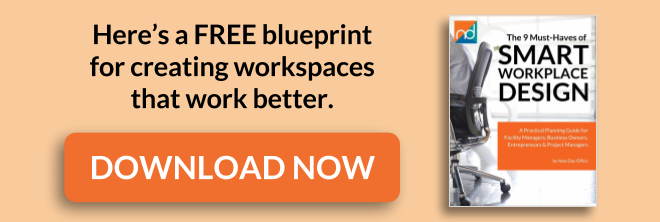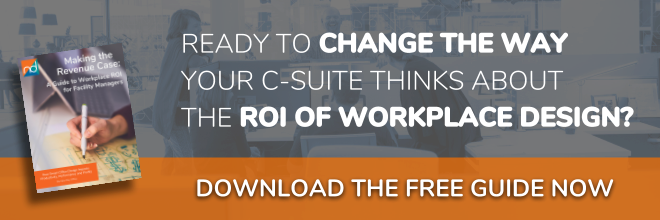How to Use Workplace Design to Improve Employee Retention
By Matt Brady

Trouble retaining top talent? Here are three keys to keeping your best employees engaged, committed and… on your payroll
“Employee retention” is a terrible phrase.
It’s one of those business terms that sounds cold and impersonal, like a holdover from the Industrial Age. Especially if you consider the standard dictionary definition of “retention,” which is “the continued possession, use, or control of something.”
Nobody wants to be possessed, used, or controlled.
So before we talk about employee retention, let’s swap words.
When it comes to employees, you don’t want to just “retain” your best people. You want to keep them engaged, satisfied and invested so that they don’t leave.
You want more than employee retention, you’re looking for employee commitment.
Recruiting the best and brightest is hard enough. Even if you manage to land a great candidate, all of that work and expense can go to waste if that seemingly perfect-fit employee doesn’t stick around very long. That’s why the idea of employee commitment ranks high on the list of things that keep your C-suite up at night.
Maybe we can blame millennials. They’ve become famous for their fickleness and it doesn’t help that studies show that they are three times more likely to resign than non-millennial employees. And when you consider that the average cost of replacing employees is about 20% of their annual salary, it’s easy to understand why CEOs have nightmares about “job-hoppers.”
But instead of blaming a generation that seemingly can’t sit still, maybe we need to take a closer look at the companies that aren’t giving them better reasons to stay put.
You can’t provide for every employee’s unique wants and desires. But there are definitely some simple, actionable design ideas that will help reduce turnover and build a deeper personal connection to your company.
But first, for any of them to work effectively, you’ll need to grant your employees three workplace superpowers: flexibility, comfort and control.

FLEXIBILITY
The power to choose when and where they work.
Embracing flexibility means expanding your definition of workspace. It literally requires thinking outside the box, whether that box is a cubicle, a private office or the four walls of your physical location.
You know that internet technology has liberated most workers from the desktop computer. Wireless networks and cloud storage mean that work can happen anywhere, anytime. You know all of this, but how much has your office embraced this fact of professional life?
If the answer is “somewhat” or “not at all,” you have some catching up to do.
Millennials are on track to make up 75% of the American workforce by 2025 and they’ve already put flexibility high on their list of workplace demands. The 2017 Deloitte Millennial Survey shows that 69% of millennial employees have a flexible schedule, with 64% working somewhere instead of (or in addition to) the office.
But it’s not just a younger generational trend. According to a 2017 workforce report, 3.9 million Americans work from home at least half the time and the median age for telecommuting workers is 46.
Flexible work is only going to get more common. According to Upwork’s 2018 Future of Workforce Report, hiring managers expect a 168% increase in the amount of work done remotely in the next 10 years.
How can you improve flexibility through design?
Flexibility is all about choice. Evaluate the space you have to determine what areas can be repurposed, expanded or adapted for new uses.
- Can private offices be converted into meeting spaces? Or vice versa?
- Can you convert an office or meeting room into a videoconference room?
- Can you add unassigned seating and/or benching areas for visiting freelancers, contractors or telecommuters?
- Do you provide a balance of open areas and more isolated spots for “heads-down” work?
- Is there space for casual, common areas where work can be done away from a desk or cube?
• Do you have a collaborative space that invites informal interactions?
Adding flexibility doesn’t have to be an all-or-nothing proposition. Start small with one area of flex space, or even a single dedicated desk or work table.
If you’re looking for more overall flexibility, consider designing a more agile workplace. There are a wide variety of modular office options that allow you to constantly reconfigure your space with demountable walls, mobile furniture and movable storage.
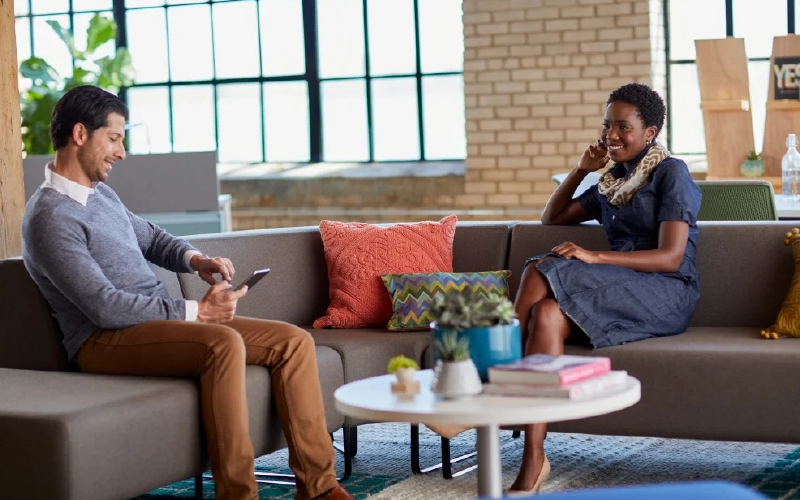
COMFORT
The power to work without pain, stress, or fatigue
There’s a saying in the Marine Corps that “pain is just weakness leaving the body.”
That’s a useful slogan if your task is to transform your body into a combat-ready assault weapon. But not so much if you’re a graphic designer brainstorming logos for an online mortgage lender.
Pain in the workplace is a bad thing. Even mild discomfort can lead to disaster.
People who work for you need to be comfortable. They need the right furniture, the right tools and the right environment to do their best work.
I believe that the single best investment you can make for any employee is a great task chair.
The right chair is essential. You’d be amazed how quickly a low-end chair can lead to discomfort and even serious injury. Providing high-quality seating also sends a signal that, as an employer, you are tuned into the basic needs of your staff.
I’ve found that it’s even more powerful when you get employees involved in the actual selection (and even design) of their chairs.
Think about someone’s first day on the job.
Instead of showing them to their desk and saying, “This is your chair now,” or, even worse, grabbing whatever chair is nearby and available, you give them the power to choose. The chair they select and design feels like it genuinely BELONGS to them.
What could have been a simple budget item purchase becomes a piece that provides a much deeper connection.
I’m not suggesting that letting employees design their own task chair means they’ll never quit, but it sends a clear message that their input matters. It gets them involved in designing their own work environment.
Offices have never been famous for comfort. But more modern workplaces are blurring the lines between the rigors of work and the comforts of home. It’s becoming standard to incorporate items like lounge seating, couches, pillows and even hammocks into the professional space.
You’ve probably seen oversized corporate campuses like Google or Amazon take ideas of comfort to the extreme with game rooms, napping pods and indoor playground equipment. But there are simpler ways to make your company space more comfortable.
How can you add more comfort through design?
- Add color or artwork to empty walls. Different colors affect mood and energy levels. Artwork adds personality to otherwise neutral spaces.
- Add plants. Greenery is a natural stress reliever and provides measurable health benefits including noise reduction and cleaner air.
- Add texture. Break up the monotony of traditional work surfaces with the introduction of natural stone, fabric wall coverings or rustic wood flooring.
- Upgrade your restroom experience. Making these spaces more comfortable can be as easy as adding personal lockers, complimentary toiletries or even a relaxing soundtrack.
- Upgrade your food and beverages. Perks like premium coffee and tea service or free snacks keep employees motivated (on-site) throughout the day.
PRO-TIP: Every one of these ideas becomes infinitely more effective if you include employees in the decision-making and design process.
Don’t forget that when considering comfort, you also need to think about environmental comfort factors such as light, temperature, air quality and noise.
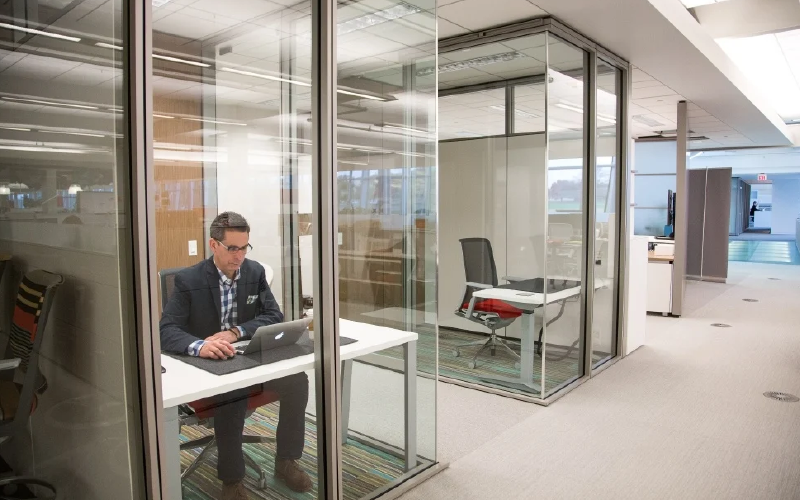
CONTROL
The power to command light, heat, and sound.
Finally, all of the work you do to improve flexibility and comfort won’t do your employees any good if they don’t have control.
People are more invested when they have control over their work environment.
Nobody wants to feel like a hostage. The less power employees have, the more they’ll look for a job that’s responsive to their needs. It’s that simple.
Control means giving employees agency over their own workday.
That includes the ability to adjust light, temperature and sound levels. This could mean allowing access to the thermostat for an office or meeting room. It could mean offering equal access to naturally lit workspaces. Or it could mean that people have the option to move from a louder open office to a quiet area for more focused tasks.
It will be up to you to establish guidelines and limits, but the key, as always, is clear communication.
How can you give more control through design?
- Reconfigure your current layout to provide options. Designate loud and quiet zones and areas for both collaboration and focus.
- Provide easy access to controls and clear guidelines for the regulation of temperature. Guidelines are key since it can be tricky to balance personal comfort with widely differing definitions of “ideal office temperature.”
- Adjust your space to allow for maximum natural light distribution. Everyone should have access to sunlit spaces.
- Involve employees in office furnishing decisions (and even design). Allow them to customize their individual workstations and provide input on group areas. If you are considering a move or redesign, get feedback and involve employees early in the process of shaping your new space.
- Make a commitment to continually improve your existing space. Even if the updates are purely cosmetic, people who choose or vote on details like paint color and carpet style will be infinitely more invested in your company than those who are expected to live with whatever is decided by leadership.
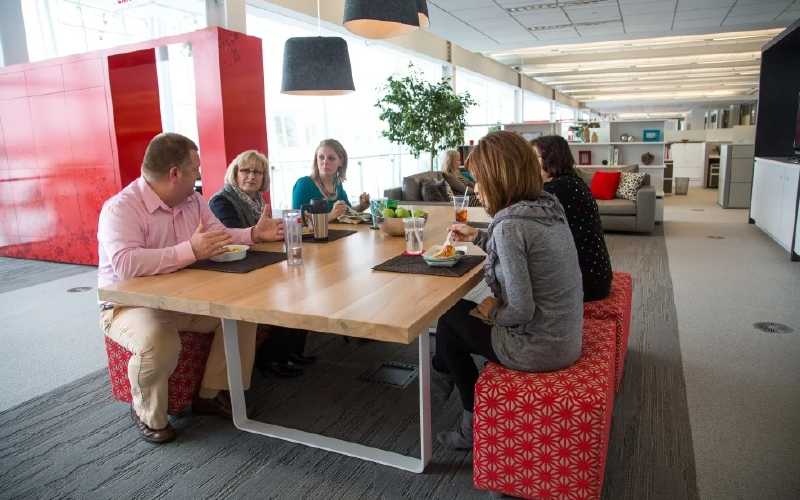
An employee-centric approach to office design gets people more invested in where they work.
If you want to keep your best people, you need to make them feel connected to your company and your culture.
You can do that by aligning your office design with the concepts of flexibility, comfort and control. As more workplaces abandon rigid traditions and embrace the live-work-play ideal, success will depend on a company’s ability to adapt and evolve.
It means changing your approach from “This is what you get” to “Tell me what you need.”
The bad news is that there’s no miracle cure for employee turnover. People switch jobs for millions of different reasons. Retention is going to remain an issue for human resources and the C-suite for the foreseeable future.
Here’s one last statistic that is both terrifying and hopeful…
That’s sobering, but it also holds a bit of good news because it shows that you can take steps to keep good people on the payroll.
You don’t have to lose them.
While workplace design will likely only be a part of your overall retention strategy, small changes you make to your physical space can have a significant impact on your bottom line.
Want to read more about smart workplace design?
- Check out additional blog articles.
- Schedule a 15-minute, no-obligation phone call to discuss your project, ask product questions, or simply solicit our professional advice.

